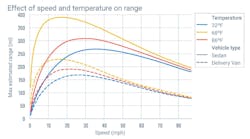Key takeaways:
- Higher ambient temperatures affect an electric vehicle's range, but the impact is more significant at low speeds.
- At higher speeds, the impact of ambient temperatures is less significant, with speed becoming the largest contributing factor to EV range because of stronger wind resistance.
- Reducing speed, precooling the cabin, and avoiding aggressive driving are among the ways drivers can maximize their EV range in the summer.
“What’s its range?”
That’s the most common question folks ask about an electric vehicle. While dealers will spout out an estimated range, an EV’s actual range is much more complicated.
"Modern EVs have increasingly large batteries, and many can comfortably handle most daily driving—including fleet routes—on a single charge,” Charlotte Argue, senior manager of sustainability at Geotab, a fleet management platform, said in a release. “But range, on EVs or ICE vehicles, will always vary with real-world conditions: temperature, topography, traffic, and yes, speed.”
What impacts EV range more in the summer: speed or heat? Fleet management platform Geotab analyzed 350,000 trips from 500 sedans and 2.8 million trips of 2,000 light cargo vans to reveal the answer.
How heat affects range
Heat waves and record-breaking temperatures across the U.S. cause drivers to blast the air conditioners in their vehicles. Hot ambient temperatures also increase the temperature of EV batteries. Keeping the cabin cool and keeping the batteries cooled requires energy from the battery.
At low speeds and driving around town, the pull of energy to keep the cabin and batteries cool is more apparent, according to Geotab data.
“At low speeds, a 10-degree change in temperature will have a much larger impact on range than any change in temperature at high speeds,” Argue noted in a blog post.
This statement is amplified by the graph below.
See also: Fleets Explained: What actually affects fuel efficiency?
How speed affects range
Speed affects range more negatively than temperature, according to Geotab data. As a result, a vehicle will encounter more wind resistance the faster it drives.
“The data shows that even modest increases in speed lead to steep range losses,” Geotab stated in a release. “For example, a 65 kWh electric van cruising at 50 mph in [86 degrees Fahrenheit] heat with the air conditioning on has a typical range of around 143 miles. Increase that speed to 60 mph and range drops to 121 miles. At 70 mph, it falls further to 103 miles, and by 80 mph, you’re down to just 88 miles. That’s a 39% drop in range between 50 and 80 mph.”
The Auto Research Center echoes this sentiment, citing a “strong relationship” with the speed a vehicle travels and the fuel required to overcome the drag experienced at higher speeds. While ARC’s focus is on race cars, the same principle applies to commercial vehicles.
“Drivers tend to worry about using the [air conditioner] in hot weather, but our data shows that your right foot can make the biggest difference, particularly at high speeds," Argue said in a release. “Just slowing down by 10 or 15 mph can extend your range by 20–30%, depending on the vehicle.”
See also: Ford E-Transit Review: An EV with an ICE soul
Ways to maximize EV range this summer
Now that it’s been established that speed impacts range far greater than hot temperatures, Geotab provides the following recommendations to ensure a maximum range in the heat of the summer.
- Reduce speeds: Small reductions can make a difference. “Dropping from 70 mph to 60 mph can add 10–20% more range,” according to Geotab.
- Cool the cabin before unplugging: Cooling the cabin using main power rather than the vehicle’s battery helps save energy for the road ahead.
- Use air conditioning efficiently: After you’ve cooled the cabin, use the vehicle’s air recirculation system. Alternatively, opting for seat ventilation (if equipped) over running the air conditioning can save energy.
- Avoid aggressive driving: Refraining from aggressive acceleration and practicing gradual braking can help preserve energy and increase regenerative braking.
- Park in the shade: A no-brainer when keeping your vehicle cool, opting to park in a shaded area can help decrease the heat buildup in a vehicle over long stints of time.
- Avoid fast-charging: Fast-charging an EV generates more heat within the battery pack. When temperatures are already warm, opt for slower charging to decrease the probability of faster long-term degradation.
About the Author
Jade Brasher
Senior Editor Jade Brasher has covered vocational trucking and fleets since 2018. A graduate of The University of Alabama with a degree in journalism, Jade enjoys telling stories about the people behind the wheel and the intricate processes of the ever-evolving trucking industry.


